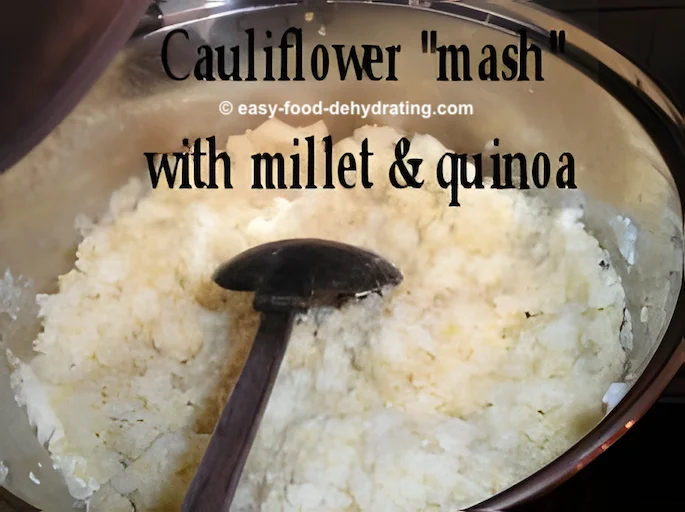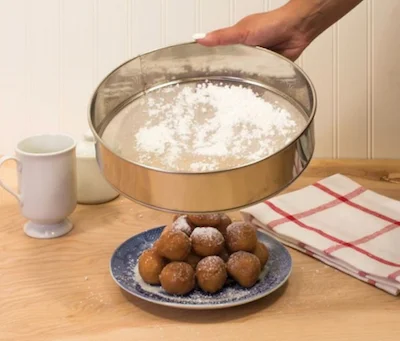What We Mean by “Dehydrate”
Here at Easy Food Dehydrating, “dehydrate” always means using an electric food dehydrator — the easy, reliable way to dry food at home.
- Home
- Easy Dehydrated Food Recipes
- Creamy Cauliflower Mash Recipe
Creamy Cauliflower Mash: A Comforting Low-Carb Side

Cauliflower mash is a creamy, low-carb alternative to mashed potatoes that delivers comfort-food flavor without the guilt. It’s rich, filling, and perfect if you want a healthier side dish that even picky eaters will enjoy.
✅ Quick Answer: How do you make cauliflower mash?
To make cauliflower mash, cook rehydrated cauliflower with onion and garlic, then blend with cooked millet and quinoa until smooth. The result is a creamy, potato-like mash that’s lower in carbs and packed with extra protein and fiber.
With a similar texture and taste to traditional mash—and a bonus boost from millet and quinoa—this dish is a smart way to sneak more nutrition into your meals while keeping the family happy.

It has a similar consistency to real mashed potatoes, and it doesn't differ much in taste either.
Go on, make it today... the kids will never know... it'll be our little secret...

Creamy Cauliflower Mash Recipe
With Millet and Quinoa
As noted below, please remember to rinse your millet and quinoa before adding it to the mix (especially the quinoa because it has a really bitter taste if you don't rinse it first).
Ingredients
- 2 cups dehydrated cauliflower
- 1/4 cup dehydrated onion
- 2 slices dehydrated elephant garlic
- 2 cups boiling water (for dehydrated items)
- 1/4 cup millet—rinse before adding to the recipe
- 1/4 cup quinoa—rinse before adding to the recipe
- salt* and pepper to taste
- 6 cups of vegetable stock
Instructions
- Use the freshly boiled water to re-hydrate the dehydrated items above, in a glass bowl or measuring jug.
- Rinse the millet and quinoa in a fine sieve in the sink.
- Cook the millet and quinoa in about two cups of water in a heavy saucepan for about 20 minutes, stirring often, while the veggies rehydrate. Add water if it dries up too fast!
- Place the rehydrated veggies in another saucepan, add the vegetable stock, and bring to a boil, then simmer for about 15-20 minutes, stirring often. NOTE: we're making 'mash' here, not a soup, so drain off excess water/stock—(save it for future use in a soup base!) and store the stock in your fridge, or freeze it in an ice-cube tray—that way you can add a cube of stock to a soup recipe!
- Combine the millet/quinoa mix with the cauliflower mix—and mash it up to your desired smoothness!
*IF you need to add salt, do so, BUT be careful NOT to over-salt as the bouillon has salt in it.
Nutrition Information
- Servings: 8 servings
- Calories: 90kcals
- Fat: 1g
- Protein: 3.7g
- Carbohydrates: 17.8g

Fresh Swap: How to Use Real Cauliflower, Onion & Garlic
If you want to use fresh ingredients that you may have on hand, do this:

Exchange the dry ingredients in the recipe, above, for these fresh ingredients listed below!
- 1 large head of cauliflower. Cut off the outer leaves and wash the cauliflower if necessary - break down into florets
- 1/2 a large onion, peeled and diced
- 2 slices of fresh elephant garlic, or 1 small clove of "regular sized" garlic
That's it!
20 Taste-Tested Easy Recipes
🍕 Pizza! 🥧 Shepherd's Pie! 🥘 Beef Stew! plus
Cauliflower Soup and Cauliflower Mash, along with crazy Carrot Soup!
Decadent Desserts: Carrot Cake and Cranberry Pineapple Pie!
and more...
Fresh food ingredient amounts are included for when you have fresh food on hand.
See which recipes are included here.
The Kitchen Tool That Makes Rinsing Grains a Breeze
For rinsing the millet and quinoa, consider getting a sifter like the one shown.
I use it for the cauliflower mash recipe and for my dog food recipe and it is from Fantes.com. It is a #50 Mrs. Anderson Sieve, 9-inch diameter stainless steel sifter.
I've used it for years and there's absolutely no sign of rusting, which is great! I highly recommend it.
After washing and drying it with a tea towel, I then leave it out to air dry by hanging on my kitchen wall.
All-in-all, cauliflower mash is an easy and tasty substitute for mashed potatoes. Try it out today!
Why Millet Deserves a Spot in Your Pantry
Millet is a very healthy gluten-free grain with several benefits:
- Highly nutritious - Millet is high in protein, fiber, antioxidants, magnesium, phosphorous, and other minerals. It contains no gluten.
- Digestible - Since millet is alkalizing, non-acidic, and easy to digest, it is considered one of the least allergenic and most digestible grains out there. This makes it gentle on the stomach.
- Prebiotic benefits - The non-digestible carbohydrates in millet serve as food for good gut bacteria which promotes overall gut health.
- Gluten-free - For those with Celiac disease or gluten intolerance, millet provides a nutritious gluten-free alternative to wheat and other grains.
Quinoa’s Superfood Secrets You’ll Love
Quinoa is very good for you due to its exceptional nutritional profile:
- Complete protein - Quinoa contains all NINE essential amino acids making it a complete protein. This is rare among grains. The protein content is also relatively high at around 4 grams per 1/4 cup uncooked.
- High fiber - Quinoa contains 5 grams of fiber per 1/4 cup. The fiber helps regulate digestion and promotes feelings of fullness.
- Complex carbohydrates - Quinoa is mainly composed of slow-digesting complex carbs rather than fast-digesting carbs. This gives you steady energy.
- High iron - Quinoa contains much more iron than other grains. This helps transport oxygen around the body and helps prevent anemia.
- Rich antioxidants - Quinoa is very high in antioxidants including quercetin, kaempferol, and ferulic acid which are said to help eliminate free radicals and reduce inflammation.
- Low glycemic index - The glycemic index of quinoa is around 53, meaning it won't cause big spikes in blood sugar levels. This is important if you're a diabetic.
- Gluten-free - Quinoa is naturally gluten-free, providing a grain option if you have Celiac disease or gluten intolerance.
- Versatile - Quinoa has a mild, nutty flavor that works well in both sweet and savory dishes - from breakfast to dinner.
Why Cauliflower Comes in White, Purple, and Orange

The pigments inside the plant give cauliflower its color. Anthocyanins create the blue and purple tones you see in purple cauliflower - and you’ll find these same pigments in blueberries and eggplant too.
Carotenoids bring out the orange shades, just like they do in carrots and sweet potatoes.
When cauliflower shows up white, it simply means those pigments aren’t there!
FAQs About Cauliflower Mash
Does cauliflower mash really taste like mashed potatoes?
Does cauliflower mash really taste like mashed potatoes?
Yes! While not identical, cauliflower mash has a similar creamy texture and mild flavor. When seasoned well, many people can’t tell the difference.
Can I make cauliflower mash with fresh cauliflower instead of dehydrated?
Can I make cauliflower mash with fresh cauliflower instead of dehydrated?
Absolutely. Swap in a head of fresh cauliflower, along with fresh onion and garlic, for the dehydrated versions in the recipe.
Is cauliflower mash keto-friendly?
Is cauliflower mash keto-friendly?
Yes. Cauliflower mash is low in carbs and high in fiber, making it a great side dish for keto or low-carb diets.
Can I freeze cauliflower mash?
Can I freeze cauliflower mash?
Yes. Store cooled mash in freezer-safe containers for up to three months. Reheat gently on the stove or microwave, adding a splash of broth if needed.
Cauliflower mash proves you can enjoy comfort food without sacrificing health—or flavor. It’s creamy, filling, and pairs perfectly with just about any main dish.
If you loved this recipe, you’ll also want to grab the free 5 Dried Food Recipes You'll Actually Love PDF below—featuring my favorites like carrot soup, minestrone, split pea soup, spicy beef jerky, and even banana cinnamon rolls!
Get 5 Dried Food Recipes You'll Actually Love
Here's where you can get your copy of our all new
5 Dried Food Recipes (That Actually Taste Great)
They're my all-time favorite easy dried food meals!
Get it here right now.
For Free!
Before You Go...
If you enjoyed this page, tap the ❤️ in the lower right-hand corner.
It saves this page to your Grow bookmarks so you can find it again later.
You’ll also see quick share buttons to copy the link, post to Facebook,
or save it straight to Pinterest.



















